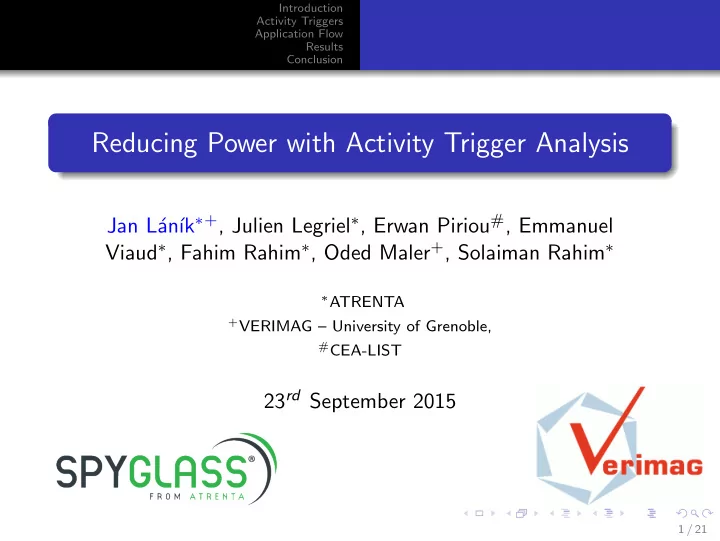

Introduction Activity Triggers Application Flow Results Conclusion Reducing Power with Activity Trigger Analysis ık ∗ + , Julien Legriel ∗ , Erwan Piriou # , Emmanuel Jan L´ an´ Viaud ∗ , Fahim Rahim ∗ , Oded Maler + , Solaiman Rahim ∗ ∗ ATRENTA + VERIMAG – University of Grenoble, # CEA-LIST 23 rd September 2015 1 / 21
Introduction Activity Triggers Application Flow Results Conclusion Motivation 2 / 21
Introduction Activity Triggers Application Flow Results Conclusion Clock gating Disabling registers when not needed by ‘gating the clock’ to save power clk gated clk clk CG en en D Q out data gated clk Problem: How to compute the enabling condition? 3 / 21
Introduction Activity Triggers Application Flow Results Conclusion Clock gating conditions - granularity Global Design decision. On the high level - whole functional blocks. Handcrafted enable conditions. Efficient, easy to implement, high in the clock tree. Local Small register groups deep in the designs. Complex, not intuitive enable conditions. Need tools to find the conditions. Expensive, but can be efficient. 4 / 21
Introduction Activity Triggers Application Flow Results Conclusion Clock gating conditions - granularity Intermediate Missing link. Medium sized blocks. Understandable, but not necessarily obvious. Human designer should be able to find them if he did a time consuming detailed analysis. Tools in demand. 5 / 21
Introduction Activity Triggers Application Flow Results Conclusion Activity Triggers Events related to a change of activity status of a design block. stop MODULE MODULE ACTIVE IDLE start 6 / 21
Introduction Activity Triggers Application Flow Results Conclusion UART example UART RECEIVER clk received CNT out reg CONTROL rst recv_byte[7:0] FSM rx is_receiving recv_error TRANSMITER CNT inp reg CONTROL transmit is_transmitting FSM tx_byte[7:0] tx uart Figure: Schema of a simple UART design 7 / 21
Introduction Activity Triggers Application Flow Results Conclusion UART transmission data transmission two stop bits line idle 1 1 1 1 line idle start bit 0 0 0 0 Figure: Serial line transmission of the character ‘K’ in the ACSCII encoding 8 / 21
Introduction Activity Triggers Application Flow Results Conclusion Stability modeling stable ( reg n − 1 ) data D Q en EN reg n � i stable ( reg i ) stable ( reg n ) D Q 9 / 21
Introduction Activity Triggers Application Flow Results Conclusion Monitor automaton d − 1 delay nodes ¬ β ∨ α ¬ α ∧ stable β ∨ ¬ α ¬ α ¬ α ¬ α · · · α MODULE α MODULE α ACTIVE IDLE ¬ stable α ∧ stable PROPERTY VIOLATION Figure: An automaton for checking the validity of activity triggers 10 / 21
Introduction Activity Triggers Application Flow Results Conclusion Formal verification flow 1 Original RTL ⇒ circuit representation 2 Stability modeling and monitor automaton added to the circuit 3 Verification using reachability engines from ABC (BMC + PDR) 11 / 21
Introduction Activity Triggers Application Flow Results Conclusion Constraint support Constraining behavior is often crucial for thae success of a formal proof Typical cases: configuration registers or input following specific pattern We support behavioral constraints expressed as System Verilog Assertions (SVA) 12 / 21
Introduction Activity Triggers Application Flow Results Conclusion Statistical detection Correlation analysis performed on vcd or fsdb traces generated from simulation For detection we consider only events that are bit/bus transitions. E.g. a signal x going from 0 to 1 or a 4-bit bus Y going from 4 ′ b 0001 to 4 ′ b 0010 1 design decomposition 2 idle periods detection 3 potential events filtering (based on size and sequential distance) 4 ranking potential events (coverage and ran measures) 13 / 21
Introduction Activity Triggers Application Flow Results Conclusion Potential start and stop signals location Stop events · · · in a short window before the beginning of stable periods Start events · · · in a short window before the end of stable periods Figure: Idle periods in a simulation 14 / 21
Introduction Activity Triggers Application Flow Results Conclusion Ranking of events Coverage · · · the ratio of idle periods that are correlated with the event Noise · · · the ratio of events that are ‘out of place’ Figure: Coverage and noise 15 / 21
Introduction Activity Triggers Application Flow Results Conclusion Automatic flow 16 / 21
Introduction Activity Triggers Application Flow Results Conclusion Semi-automatic flow 17 / 21
Introduction Activity Triggers Application Flow Results Conclusion SENDS – A video processing architecture 18 / 21
Introduction Activity Triggers Application Flow Results Conclusion SENDS results 19 / 21
Introduction Activity Triggers Application Flow Results Conclusion Automatic mode results design power power covered # registers reg-covered 1 4.169 mW 75.84% 26680 37.17% 2 7.163 mW 54.93% 9128 56.38% 3 0.479 mW 49.62% 1352 82.84% 4 7.145 mW 49.47% 9128 13.56% 5 5.314 µ W 31.04% 326 33.74% 6 0.606 mW 16.30% 2070 6.96% 7 8.891 mW 15.58% 690 28.70% 8 92.491 mW 6.77% 30520 4.65% 9 55.851 mW 4.54% 107848 8.14% 10 92.444 mW 2.87% 114546 1.56% 11 1.430 µ W 1.61% 162 14.81% 12 4.079 mW 0.70% 5292 0.15% 13 149.955 mW 0.61% 111012 1.11% 20 / 21
Introduction Activity Triggers Application Flow Results Conclusion Main contributions Activity triggers = New class intermediate-block-site clock gating conditions Heuristical detection of activity triggers based on RTL simulation trace analysis Formal method to prove validity Semiautomatic and automatic methodology integrated within a commercial tool Thank you! 21 / 21
Recommend
More recommend